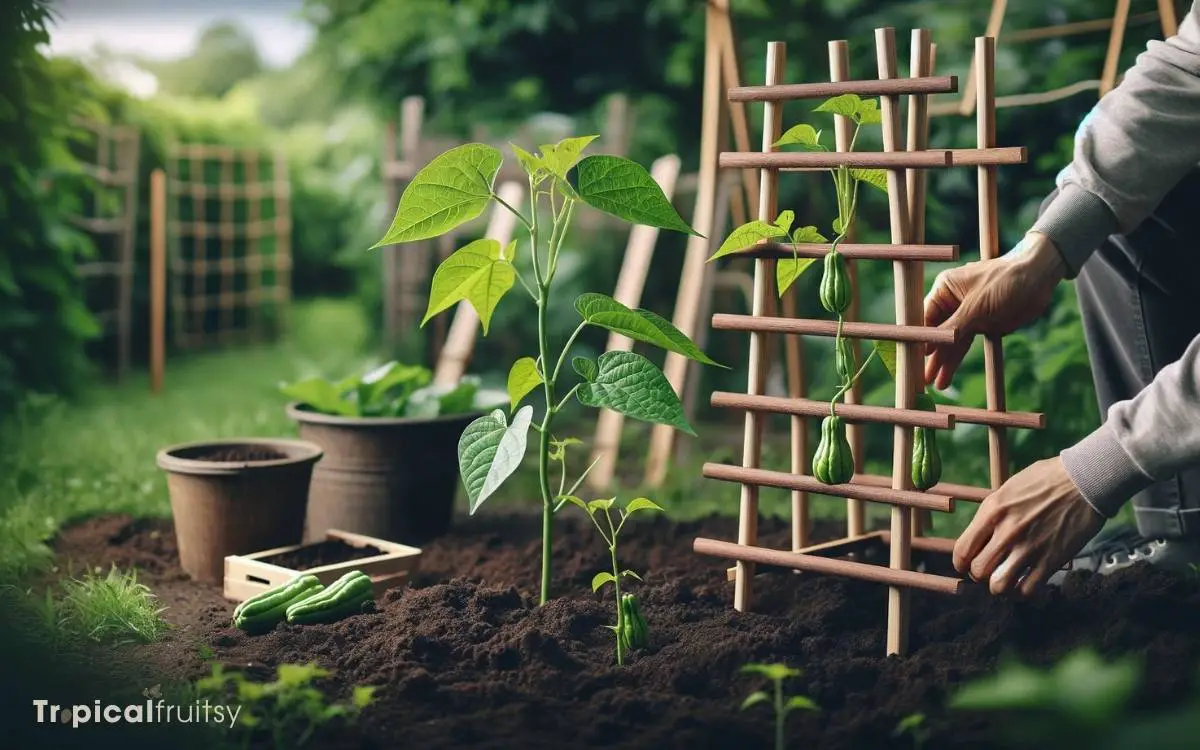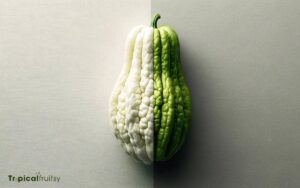How to Make Trellis for Chayote? 4 Easy Steps!
To make a trellis for chayote, you will need sturdy materials like wooden posts, metal poles, or bamboo canes. Set them up in a row and secure them in the ground at least 2 feet deep to provide stability.
Next, attach horizontal supports such as wires, trellis netting, or string lines across the vertical structures to create a grid that the chayote vines can climb on.
Ensure the trellis is tall enough to accommodate the full growth of the plant, which can reach over 10 feet.
Chayote (Sechium edule), also known as vegetable pear, is a vigorous vine that requires a strong support system to grow effectively.
A trellis provides the necessary structure for chayote vines to climb, ensuring better air circulation, sunlight exposure, and ease of harvest.
When building a trellis:
For example, you could use 8-foot tall wooden posts spaced 5 feet apart, with wire strung horizontally every 10 inches to support the growing vines.
Building a robust trellis for chayote will encourage healthy growth and yield, making it easier for gardeners to tend and harvest these versatile vegetables.

Key Takeaway
Understanding Chayote Growth Habits
In consideration of the climbing nature of chayote (Sechium edule), it is essential to understand its vigorous growth pattern and propensity for vertical expansion when planning to construct an appropriate trellis system.
This perennial vine can reach lengths of up to 15 meters, necessitating a sturdy and well-anchored structure to support its weight and facilitate air circulation, critical for preventing disease.
Its tendrils grasp onto supports, allowing the plant to ascend and spread efficiently. Designing a trellis should therefore account for the mature size of the plant, ensuring that the distance between supports is sufficient to bear the weight of the fruiting vines.
A well-constructed trellis also enables easier harvesting and maintenance, underscoring the importance of foresight in its design.
Gathering Your Trellis Materials
Selecting the appropriate materials for your chayote trellis is pivotal to ensure its durability and effectiveness.
Consider materials that can withstand the elements and the weight of mature plants, such as treated wood, metal, or sturdy plastic.
To manage costs without compromising quality, explore cost-effective options like repurposed items or sourcing materials during sales at local hardware stores.
Material Durability Consideration
Considering material durability is essential when gathering supplies for your chayote trellis, as it must withstand varying weather conditions and the weight of maturing plants.
The longevity of your trellis depends on selecting resilient materials that can endure the elements and the vigorous growth of chayote vines.
It is crucial to choose materials that do not rot easily, resist rusting, and are sturdy enough to support the plant’s development.
| Material Type | Durability Features |
|---|---|
| Cedar Wood | Naturally rot-resistant, sturdy |
| Galvanized Steel | Rust-resistant, high tensile strength |
| Vinyl | Weatherproof, low maintenance |
| Treated Pine | Chemical rot-prevention, long-lasting |
| Aluminum | Lightweight, corrosion-resistant |
Selecting the right materials is a balance between cost-effectiveness and durability, ensuring a stable structure for your chayote to thrive.
Cost-Effective Options
Budget-conscious gardeners can source affordable trellis materials without compromising quality by exploring options such as repurposed items or local hardware store deals.
When constructing a trellis for chayote, materials can be both cost-effective and durable if chosen wisely.
Here are four cost-effective options for gathering trellis materials:
- Bamboo Stakes: Frequently found at a reasonable cost, bamboo is sturdy and suitable for supporting chayote vines.
- Wooden Pallets: Often available for free from local businesses, wooden pallets can be disassembled and reused as trellis material.
- Recycled Metal Pipes: Salvaged metal pipes provide a robust frame for a trellis and can sometimes be found at scrap yards.
- Plastic Netting: An inexpensive alternative to wire mesh, plastic netting is lightweight and easy to install.
Next, we’ll consider the tools required for assembly, ensuring that your trellis is built efficiently and stands strong.
Tools Required for Assembly
Typically, assembling a chayote trellis requires a hammer, drill, saw, pliers, and measuring tape to ensure precision and stability. Each tool has a specific function in the construction process.
The hammer is used for driving stakes into the ground and nails into wood, securing the trellis structure. A drill is essential for making pilot holes for screws, which add more strength than nails alone.
The saw is used to cut lumber or other materials to the required lengths. Pliers can be handy for bending wires or metal fixtures used in the trellis construction.
Lastly, a measuring tape is indispensable for ensuring that all components of the trellis are cut to the correct dimensions and that the structure is symmetrical.
| Tool | Purpose |
|---|---|
| Hammer | Driving stakes and nails |
| Drill | Creating pilot holes for screws |
| Saw | Cutting materials to size |
| Pliers | Bending wires or metal fixtures |
| Measuring Tape | Ensuring precise measurements and symmetry |
Step 1: Designing Your Trellis Structure
Having gathered the necessary tools, it is now essential to meticulously plan the structure of your chayote trellis, taking into account the plant’s growth habits and space requirements.
Chayote vines can become quite heavy and vigorous, so your design should prioritize strength and durability.
Here’s a concise list to guide your design process:
- Measure Your Space: Allocate enough area for the vines to spread, typically a few square feet per plant.
- Choose a Shape: A-frame, arched, or flat; each offers different benefits for maintenance and harvest.
- Select Materials: Opt for weather-resistant wood, metal, or sturdy plastic.
- Consider Accessibility: Ensure there’s room to tend and harvest the plant without damaging the vines or the trellis.
This framework will help you create a robust trellis suited to the unique needs of your chayote plants.
Step 2: Assembling the Trellis Framework
Generally, the assembly of your chayote trellis framework begins with laying out the selected materials according to your design plan.
Carefully measure and position the posts at the predetermined spots, ensuring they are evenly spaced and aligned. If using wooden posts, pre-drill holes to prevent splitting when inserting screws or nails.
Connect horizontal support beams to establish a sturdy base. For metal trellises, securely fasten joints with appropriate bolts or clamps.
Attach additional bracing as needed to fortify the structure against the weight of the chayote vines. Use a level to verify that each component is properly aligned for optimal stability.
Once the basic frame is constructed, proceed to add the lattice or netting, affixing it tightly to prevent sagging.
Step 3: Installing the Trellis Securely
Upon completing the assembly of your chayote trellis, it is crucial to anchor the structure firmly in the ground to withstand environmental stresses.
Here are key steps to ensure a secure installation:
- Dig Post Holes: At each corner of the trellis, dig holes that are at least two feet deep to provide a stable base.
- Use Concrete Footings: For additional stability, pour concrete around the base of the posts in the holes to set them securely.
- Install Bracing: Attach horizontal and diagonal braces between posts to reinforce the trellis against wind and the weight of the chayote vines.
- Check for Level and Plumb: Use a spirit level to verify that posts are vertically aligned and the top cross-pieces are horizontal before the concrete sets.
Step 4: Maintaining Your Chayote Trellis
Once your chayote trellis is in place, ongoing maintenance is crucial to ensure its longevity and the health of your plants.
Conducting regular inspection checks can identify early signs of wear or weakness, allowing for timely interventions before significant damage occurs.
Pruning overgrown vines and repairing any structural damage promptly will support the trellis’s stability and facilitate optimal chayote growth.
Regular Inspection Checks
After constructing your chayote trellis, perform weekly inspections to ensure its stability and to identify any necessary repairs or adjustments. Regular checks are crucial for the longevity of your trellis and the health of your chayote plants.
Here are four key aspects to focus on during your inspections:
- Support Structures: Verify that posts and crossbeams remain firmly in the ground and are not showing signs of weakness or rot.
- Connective Materials: Check that ties, wires, or netting are secure and intact, replacing any that are damaged.
- Plant Health: Look for signs of disease or pest infestation on the chayote vines that could affect the trellis.
- Growth Management: Ensure the vines are properly guided and supported, adjusting as necessary to prevent overburdening any part of the trellis.
Pruning Overgrown Vines
Throughout the growing season, diligent pruning of overgrown vines is essential to maintain the structural integrity and effectiveness of your chayote trellis.
As the chayote plant matures, it tends to grow vigorously, producing lengthy vines that can become heavy and unruly. To prevent these vines from overwhelming the trellis and impeding air circulation, regular pruning is advised.
Remove any dead or diseased stems first, as these can be sites for pests and diseases. Then, trim back excessively long or entangled vines, particularly those that are not producing fruit or are shading lower areas excessively.
This selective reduction not only preserves the trellis’s shape but also directs the plant’s energy into producing larger, healthier chayotes.
Use clean, sharp pruning shears to make precise cuts, which will facilitate quick healing and regrowth.
Repairing Structural Damage
Regular inspection of your chayote trellis is crucial for identifying and repairing any structural damage that may compromise the support of the vigorous vines.
To maintain your trellis effectively, follow these practical steps:
- Inspect Regularly: Check for broken, rotten, or weak spots on the trellis, especially after extreme weather conditions.
- Strengthen Joints: Reinforce any loose joints with additional screws or metal brackets to ensure stability.
- Replace Damaged Parts: Remove and replace any parts of the trellis that are beyond repair with new, durable materials.
- Preventative Care: Apply wood preservative or rust-resistant paint to wooden or metal parts, respectively, to prevent future damage.
Conclusion
Constructing a robust trellis for chayote cultivation necessitates an understanding of the plant’s vining habits, sourcing appropriate materials, and employing suitable tools for assembly.
A well-designed trellis supports the plant’s growth and productivity. For instance, a community garden in the temperate coastal region successfully implemented a sturdy A-frame trellis, resulting in enhanced chayote yields.
Regular maintenance ensures the trellis remains effective throughout the plant’s lifecycle, demonstrating its practical value in chayote cultivation.






